While many blame international financial institutions, much of the blade lies with the institutionalized corruption within the political system. The president in the lead up to the disaster managed to increase his personal wealth by $8 billion US dollars - and you can bet that his dollars did not get converted to pesos and frozen for 10 years.
 On our first night in town we walked the few block from our hotel to the presidential palace, only to find this candle light vigil.
On our first night in town we walked the few block from our hotel to the presidential palace, only to find this candle light vigil.
The candles are on top of a barrier that keeps the people away from the palace. This is the famous pink palace from the balcony of which Juan Peron and Evita urged on their supporters. No one in the balcony tonight.
Only later did we discover that the rally was protesting police corruption. There are about 400 kidnappings a year in Buenos Aires. It is widely believed that the kidnappers are in fact the police. This allegation appears in local newspapers. This has been going on for some time and would normally not justify a vigil. It happens though that the last kidnapping was botched and even though the family was prepared to pay the ransom, the police bungled the raid and the abductee was killed.
The young man killed was quite charismatic, the father quite well spoken. A powerful movement formed against police corruption. A quick check (July 1, '04) of the Buenos Aires Herald shows that the problem of police corruption is still causing protest, with demonstrators overrunning police stations and regular purges of (presumably the corrupt members of the) police ranks.
|
 A second shot, showing the famous balcony. You can almost see Madonna there, but for the glare of the candles.
A second shot, showing the famous balcony. You can almost see Madonna there, but for the glare of the candles.
These kidnapping should not deter tourism. They only kidnap the children of wealthy locals, people who can readily afford the ransom. No point in kidnapping a backpacker. Buenos Aires is far safer than we had been led to believe. We had absolutely no problems, nor did we sense any problems, during our days in this town.
|
 Evidence that the locals are more than a little bitter about their treatment by the banks - this branch of the Lloyd's bank is completely armored.
Evidence that the locals are more than a little bitter about their treatment by the banks - this branch of the Lloyd's bank is completely armored.
In July '04 Lloyds decided it had had enough and announced it was pulling out of Argentina. Fair or not, the perception that the banks are responsible for the problem, or at least profited in some way, seems to be driving them out of Argentina.
|
 This is much more the standard evening in Buenos Aires. This is an open air plaza in the Tango quarter which is filled with chairs and tables from the restaurants surrounding the square after about 9PM. The square quickly fills with people having a drink before dinner. There is no Waldo in this picture, just locals.
This is much more the standard evening in Buenos Aires. This is an open air plaza in the Tango quarter which is filled with chairs and tables from the restaurants surrounding the square after about 9PM. The square quickly fills with people having a drink before dinner. There is no Waldo in this picture, just locals.
|
 Even though this is Tango town, the dance demonstration is Flamenco. This night just the semi-professional couple - the woman walks around the audience with a hat after the show. Some nights people in the audience also dance - it looks a bit like a dance class gets to strut their stuff.
Even though this is Tango town, the dance demonstration is Flamenco. This night just the semi-professional couple - the woman walks around the audience with a hat after the show. Some nights people in the audience also dance - it looks a bit like a dance class gets to strut their stuff.
On the lower left of the picture you can see several young girls. No babysitters in this town - people bring their kids along to the square, often staying until after midnight.
|
 The underside of the depressed economy - the recycling network.
The underside of the depressed economy - the recycling network.
People put their garbage out in the street every evening. Trucks come around collecting it between midnight and the early hours. [Warning - if you get a hotel room on the street you will hear the garbage collection happening.]
Between when the garbage goes out and the trucks come around the informal recycling system goes into action. The main item of interest appears to be cardboard, but lots of stuff gets picked and collected.
This is happening while people are sitting in the plazas having a beer before dinner.
|
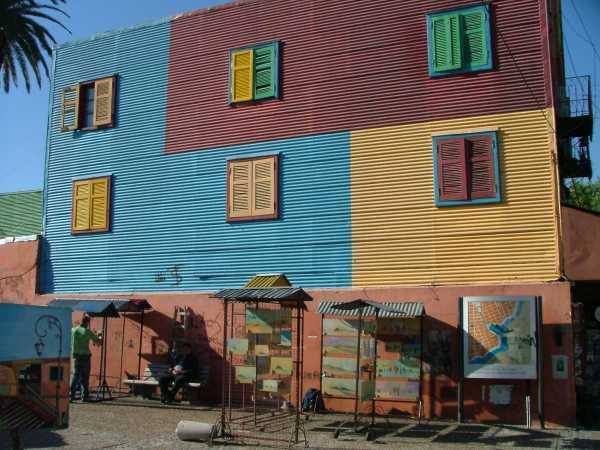 One of the more colourful neighbourhoods in Buenos Aires is called La Boca.
One of the more colourful neighbourhoods in Buenos Aires is called La Boca.
Many of the buildings are brightly painted and feature this corrugated paneling. It is an artistic area and a tour bus stopping point. It also has lots of the usual tourist traps selling tacky souvenirs.
|
 The Theatre Colon in Buenos Aires is fabulous. Built using European architects and marble in the years just before and after 1900, it is a huge building in the European Opera house tradition. This picture shows a bit of the interior (pictures not allowed) of the 3,000 seat main theatre.
The Theatre Colon in Buenos Aires is fabulous. Built using European architects and marble in the years just before and after 1900, it is a huge building in the European Opera house tradition. This picture shows a bit of the interior (pictures not allowed) of the 3,000 seat main theatre.
The city of Buenos Aires subsidizes the theatre heavily. During the 9 month season they have shows almost every night - Opera, Ballet, Orchestra, Drama - usually by their resident companies. Prices range from $2 in the upper balconies to $40 for the best Loge seats.
The tour which we took is great as well. It begins with an aria, then a walk through the building showing the various studios, the set building area, the costume area, and the main theatre. Our guide was extremely knowledgeable - knew all the history of the building and the companies.
|
 Buses an Argentina are absolutely amazing.
Buses an Argentina are absolutely amazing.
There are three categories of really great travel:
-
semi-Cama
About equal to most airline first class seats. You can tilt the seat back a bit more than on a plane and leg room is not a problem. This is not like bus travel in Ecuador (which on a masochist can enjoy - oh hi Joe!).
-
full-Cama
Still more leg room and you can tilt back the seat almost to a flat bed.
-
First Class
The chair tilts back flat. Your area is separated by a partition from the seats ahead and behind, by a curtain from the one beside you. Meals, somewhat less than first class airline fair but more than coach class, are included, as is champagne and wine with dinner. You really do not need to get off the bus - they provide all meals and their is a washroom.
The overnight 1,500 kilometre trip from Buenos Aires to Iguazu costs about $100 in First Class and goes from downtown to downtown. Our hotel in Iguazu was half a block from the station. And they take bicycles (for a small charge).
|
 This is the main street in the tourist section of Colonia. With the plane trees, it looks much like any small European town.
This is the main street in the tourist section of Colonia. With the plane trees, it looks much like any small European town.
A small tourist town, Colonia began as a Portuguese smuggling town. There is a small historical quarter with the typical buildings of this period.
|
 Again, late at night and everyone is in the square watching a small orchestra. This is part of the easter celebration.
Again, late at night and everyone is in the square watching a small orchestra. This is part of the easter celebration.
|
 A small restaurant with a few tables on the street, dinner at 11 PM.
A small restaurant with a few tables on the street, dinner at 11 PM.
The couple in the background, walking to the left down the street, has their baby with them. The man is carrying the child in his arms. Children get used to the late night walks through the downtown from the very start.
Perhaps if we had done this as children, rather than being sent off to bed at 7 PM, we would be better able today to handle these late nights. Brenda looks awake in this picture, but it is just that she has mastered sleeping with her eyes open.
|
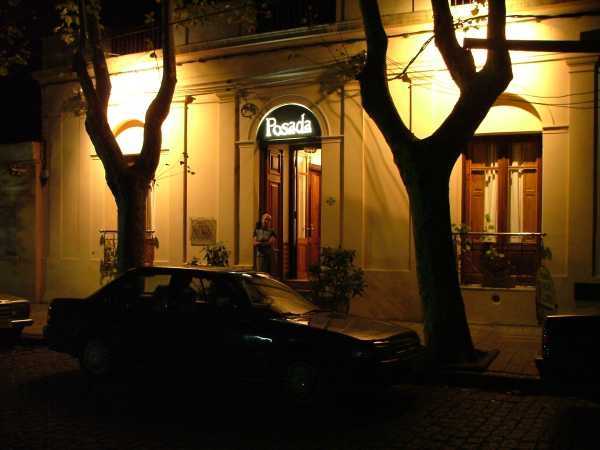 We stayed at this small hotel or Posada, just off the main street. The window on the right is our room. We seem to have been the only guests. A very nice room, 15 foot ceilings, very nice furniture.
We stayed at this small hotel or Posada, just off the main street. The window on the right is our room. We seem to have been the only guests. A very nice room, 15 foot ceilings, very nice furniture.
|
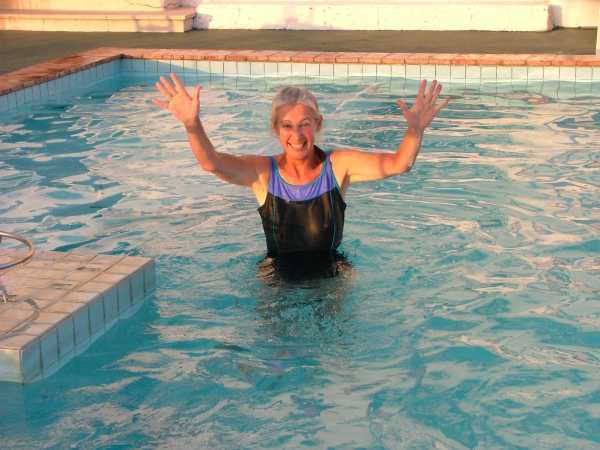 We headed north east along the river, stopping first at the small town of Carmello. This is primarily a tourist town, again for visiting Argentinians. This hotel has a casino, although we did not actually see it. It also has a pool and Brenda finally got to use the bathing suit she had brought along for 7 months.
We headed north east along the river, stopping first at the small town of Carmello. This is primarily a tourist town, again for visiting Argentinians. This hotel has a casino, although we did not actually see it. It also has a pool and Brenda finally got to use the bathing suit she had brought along for 7 months.
|
 From Carmello we headed north through agricultural lands. This is a small rodent that we saw occasionally. It was pretty shy though.
From Carmello we headed north through agricultural lands. This is a small rodent that we saw occasionally. It was pretty shy though.
This part of Uruguay has almost no signs of people along the roads. The farms are very large and the land rolls enough that the homes can rarely be seen from the road. So we cycled along looking at the fields and not much else.
|
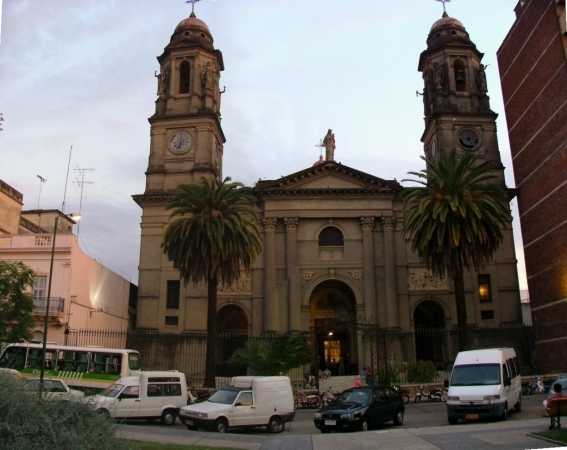 This is the cathedral in Mercedes. This is easter week and the church was packed for the evening service even though it was a week night. The cathedral is the biggest building in town.
This is the cathedral in Mercedes. This is easter week and the church was packed for the evening service even though it was a week night. The cathedral is the biggest building in town.
Its about 7 PM, the sun is setting, we have been cycling all day and are looking for a restaurant and a beer. The only place in town that is open this early is a Pizza joint. Oh, well!
|
 Heading out of Mercedes toward Paysandu, we noticed a few people in lawn chairs at the ends of driveways. Since the farms are so big we could not see the houses, just the people in lawn chairs by the road.
Heading out of Mercedes toward Paysandu, we noticed a few people in lawn chairs at the ends of driveways. Since the farms are so big we could not see the houses, just the people in lawn chairs by the road.
Then a few cars with flags came past, heading the other way. A few police cars in the wrong lane, heading the other way. Then this group of cyclists came zooming past.
It is the Tour de Uruguay and this is the lead pack. You can just see the last ride in this group waving to us.
|
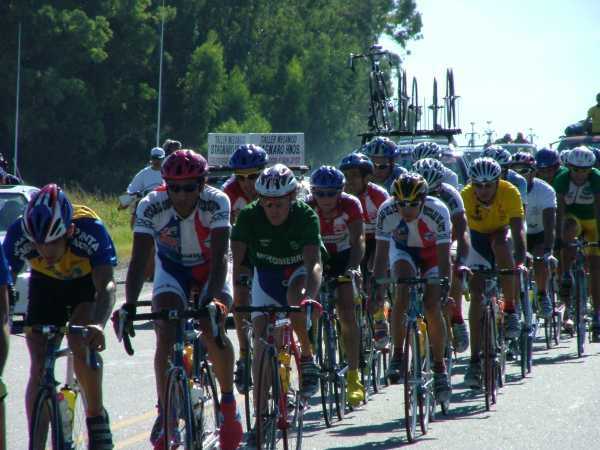 Then the pack was on us.
Then the pack was on us.
This is not a large race by Tour de France standards. No more than 100 cyclists in all. The lead pack appeared over the hill, a short gap, then the field appeared and zoomed past. I only managed these two shots then they were gone.
|
 The industrial town of Paysandu is struggling through this downturn. Like Canada would suffer if there was a deep depression in the US, Uruguay is suffering through this Argentinian depression. The night club behind this wall appears to be closed now.
The industrial town of Paysandu is struggling through this downturn. Like Canada would suffer if there was a deep depression in the US, Uruguay is suffering through this Argentinian depression. The night club behind this wall appears to be closed now.
|
 We saw a lot of old cars like this one - cars that might have been in garages until the downturn are now out on the streets.
We saw a lot of old cars like this one - cars that might have been in garages until the downturn are now out on the streets.
|
 Some people have gone back to older forms of transportation.
Some people have gone back to older forms of transportation.
|
 Montevideo is the capital and the only really large city in Uruguay.
Montevideo is the capital and the only really large city in Uruguay.
The downtown is dominated by this rather fanciful building, the Palacio Salvo.
|
 Here is a closeup of one of the towers on the Palacio Salvo.
Here is a closeup of one of the towers on the Palacio Salvo.
|
 There are some nice older building like this Palacio Brasil that are still in pretty good shape, but many of the older buildings are not being maintained. The downtown area has a devastated appearance.
There are some nice older building like this Palacio Brasil that are still in pretty good shape, but many of the older buildings are not being maintained. The downtown area has a devastated appearance.
|
 The main square is dominated by this huge statue of the liberator of Uruguay - General Artigas. This statue is about 50 feet tall - by far the biggest statue we saw on our trip.
The main square is dominated by this huge statue of the liberator of Uruguay - General Artigas. This statue is about 50 feet tall - by far the biggest statue we saw on our trip.
Like other Spanish towns in the Americas, many of the street names celebrate battles during the fight for independence or the historical figures of the independence era.
As far as I can tell, General Artigas never actually won a battle. In fact, after losing a big battle he spent most of the rest of his life in exile in Paraguay. Uruguay achieved its independence when England decided that it would form a good buffer between the Portuguese in Brasil and the Spanish in Argentina, so declared it independent. No actual battles were fought gaining independence. And still, they memorialize what battles there were and the generals they had.
|
 Beneath the statue of Artigas is a mausoleum. This is a huge room, all below ground, containing the great General's ashes. It has a guard of two soldiers, who stand at attention at all times.
Beneath the statue of Artigas is a mausoleum. This is a huge room, all below ground, containing the great General's ashes. It has a guard of two soldiers, who stand at attention at all times.
I made the mistake of sitting down in this room, hoping to put my camera on the floor to get a good shot of this room - hand held would be too jerky. A loudspeaker spoke some harsh words in Spanish almost right away. A Spanish speaking person in the room whispered "get up! get up!". I guess you are not allowed to sit in the presence of greatness.
This was the best I could so standing.
|
 Looking up the main street from the monument, on a Sunday afternoon, we see ... nothing. Almost no cars, almost no people. Whatever people do here on Sundays it is not done in the downtown.
Looking up the main street from the monument, on a Sunday afternoon, we see ... nothing. Almost no cars, almost no people. Whatever people do here on Sundays it is not done in the downtown.
|
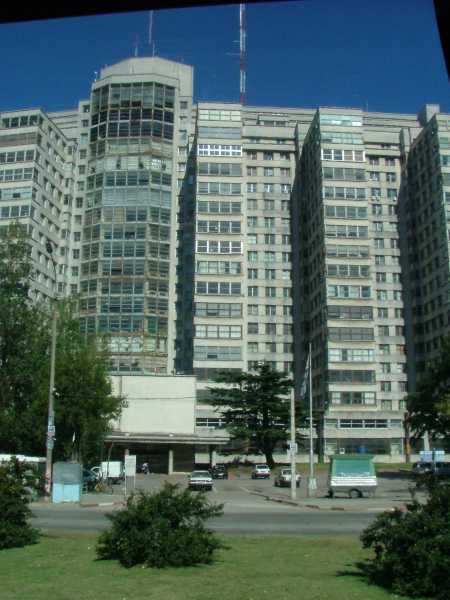 An indication of how tough the economy is - this is the main hospital in Montevideo. It is hard to see in this picture, but it appears that most of the rooms are completely empty - no beds, no equipment.
An indication of how tough the economy is - this is the main hospital in Montevideo. It is hard to see in this picture, but it appears that most of the rooms are completely empty - no beds, no equipment.
|
 Another bus trip got us to the eastern boarder of Uruguay, near Brasil.
Another bus trip got us to the eastern boarder of Uruguay, near Brasil.
We spent one night in the small boarder town of Chuy, then cycled a few kilometers to the picturesque hotel Fortin San Miguel.
This hotel is an old fort - with 2 foot thick stone walls. At times it is full, hosting mainly Brasilians. Right now it is almost empty. It is the only place around, so we ate meals in the hotel dining room.
Unfortunately, this hotel has no air conditioning and it was a little warm even though it is almost winter in Uruguay. I cannot imagine being here in the summer, no matter how pretty the building is. The surrounding country is flat with lots of small pools to breed mosquitoes.
|
 From San Miguel we cycled to Puenta del Diablo, a very small coastal fishing village and tourist destination for Uruguayans. This small building, a home and a convenience store, is typical of the houses in this town.
From San Miguel we cycled to Puenta del Diablo, a very small coastal fishing village and tourist destination for Uruguayans. This small building, a home and a convenience store, is typical of the houses in this town.
We stayed at a very small Posada, a four suite almost B&B. Most of the accommodation is rental homes - people rent a house for a week during the season. Right now though is not the season - there are no other tourists of any nationality. All the stores and restaurants are closed. We managed to find some food - fruit and nuts, somewhat like Christmas in Tasmania.
Mid April is not the time to be a tourist in Uruguay.
Brenda is bringing beer and crackers from this store just across the street (most of the streets are unpaved in this town and difficult even for cyclists).
|
 While waiting out a sudden shower at a bus stop the next day, I noticed this small frog clinging to a bamboo stalk.
While waiting out a sudden shower at a bus stop the next day, I noticed this small frog clinging to a bamboo stalk.
|
 This is the South American version of the Ostrich - the Greater Rhea. Like the Ostrich, these birds are flightless. Since most of Uruguay is fenced, meaning flightless birds cannot actually get around at all, these must be birds put here by the landowner.
This is the South American version of the Ostrich - the Greater Rhea. Like the Ostrich, these birds are flightless. Since most of Uruguay is fenced, meaning flightless birds cannot actually get around at all, these must be birds put here by the landowner.
|
 Cycling along a gravel road from the main inter-city highway to the coast, we saw several large black spiders - tarantulas?
Cycling along a gravel road from the main inter-city highway to the coast, we saw several large black spiders - tarantulas?
For some reason my camera had a lot of trouble focusing on black objects so this is a little out of focus.
|
 This small ferry, near the town Jose Ignacio, actually handles cars as well as people and is part of the road system - it operates 12 hours a day and is free.
This small ferry, near the town Jose Ignacio, actually handles cars as well as people and is part of the road system - it operates 12 hours a day and is free.
It is guided by two cables, one of either side, that must just lie on the bottom except when the ferry is crossing. The small boat on the left is tied to the ferry and just pushes against its ropes to drive the ferry from one side to the other. Pretty low tech.
|
 This amazing bridge crosses a river in a small town just east of Punta del Este. Its like someone took the idea of speed bumps and kicked it up a few notches.
This amazing bridge crosses a river in a small town just east of Punta del Este. Its like someone took the idea of speed bumps and kicked it up a few notches.
|
Notice that these fancy homes have no fences or stone walls around them. That suggests a low crime area. It looks like there is not a lot of crime in Uruguay, but the current depression could be testing that theory.

The food is very good though, the costs not too bad but not cheap, and if you don't travel during Easter there should be no problem with hotels.
Back to the Argentina page this way
 On our first night in town we walked the few block from our hotel to the presidential palace, only to find this candle light vigil.
On our first night in town we walked the few block from our hotel to the presidential palace, only to find this candle light vigil.
 A second shot, showing the famous balcony. You can almost see Madonna there, but for the glare of the candles.
A second shot, showing the famous balcony. You can almost see Madonna there, but for the glare of the candles.
 Evidence that the locals are more than a little bitter about their treatment by the banks - this branch of the Lloyd's bank is completely armored.
Evidence that the locals are more than a little bitter about their treatment by the banks - this branch of the Lloyd's bank is completely armored.
 This is much more the standard evening in Buenos Aires. This is an open air plaza in the Tango quarter which is filled with chairs and tables from the restaurants surrounding the square after about 9PM. The square quickly fills with people having a drink before dinner. There is no Waldo in this picture, just locals.
This is much more the standard evening in Buenos Aires. This is an open air plaza in the Tango quarter which is filled with chairs and tables from the restaurants surrounding the square after about 9PM. The square quickly fills with people having a drink before dinner. There is no Waldo in this picture, just locals.
 Even though this is Tango town, the dance demonstration is Flamenco. This night just the semi-professional couple - the woman walks around the audience with a hat after the show. Some nights people in the audience also dance - it looks a bit like a dance class gets to strut their stuff.
Even though this is Tango town, the dance demonstration is Flamenco. This night just the semi-professional couple - the woman walks around the audience with a hat after the show. Some nights people in the audience also dance - it looks a bit like a dance class gets to strut their stuff.
 The underside of the depressed economy - the recycling network.
The underside of the depressed economy - the recycling network.
 One of the more colourful neighbourhoods in Buenos Aires is called La Boca.
One of the more colourful neighbourhoods in Buenos Aires is called La Boca.
 The Theatre Colon in Buenos Aires is fabulous. Built using European architects and marble in the years just before and after 1900, it is a huge building in the European Opera house tradition. This picture shows a bit of the interior (pictures not allowed) of the 3,000 seat main theatre.
The Theatre Colon in Buenos Aires is fabulous. Built using European architects and marble in the years just before and after 1900, it is a huge building in the European Opera house tradition. This picture shows a bit of the interior (pictures not allowed) of the 3,000 seat main theatre.
 Buses an Argentina are absolutely amazing.
Buses an Argentina are absolutely amazing.
 This is the main street in the tourist section of Colonia. With the plane trees, it looks much like any small European town.
This is the main street in the tourist section of Colonia. With the plane trees, it looks much like any small European town.
 Again, late at night and everyone is in the square watching a small orchestra. This is part of the easter celebration.
Again, late at night and everyone is in the square watching a small orchestra. This is part of the easter celebration.
 A small restaurant with a few tables on the street, dinner at 11 PM.
A small restaurant with a few tables on the street, dinner at 11 PM.
 We stayed at this small hotel or Posada, just off the main street. The window on the right is our room. We seem to have been the only guests. A very nice room, 15 foot ceilings, very nice furniture.
We stayed at this small hotel or Posada, just off the main street. The window on the right is our room. We seem to have been the only guests. A very nice room, 15 foot ceilings, very nice furniture.
 We headed north east along the river, stopping first at the small town of Carmello. This is primarily a tourist town, again for visiting Argentinians. This hotel has a casino, although we did not actually see it. It also has a pool and Brenda finally got to use the bathing suit she had brought along for 7 months.
We headed north east along the river, stopping first at the small town of Carmello. This is primarily a tourist town, again for visiting Argentinians. This hotel has a casino, although we did not actually see it. It also has a pool and Brenda finally got to use the bathing suit she had brought along for 7 months.
 From Carmello we headed north through agricultural lands. This is a small rodent that we saw occasionally. It was pretty shy though.
From Carmello we headed north through agricultural lands. This is a small rodent that we saw occasionally. It was pretty shy though.
 This is the cathedral in Mercedes. This is easter week and the church was packed for the evening service even though it was a week night. The cathedral is the biggest building in town.
This is the cathedral in Mercedes. This is easter week and the church was packed for the evening service even though it was a week night. The cathedral is the biggest building in town.
 Heading out of Mercedes toward Paysandu, we noticed a few people in lawn chairs at the ends of driveways. Since the farms are so big we could not see the houses, just the people in lawn chairs by the road.
Heading out of Mercedes toward Paysandu, we noticed a few people in lawn chairs at the ends of driveways. Since the farms are so big we could not see the houses, just the people in lawn chairs by the road.
 Then the pack was on us.
Then the pack was on us.
 The industrial town of Paysandu is struggling through this downturn. Like Canada would suffer if there was a deep depression in the US, Uruguay is suffering through this Argentinian depression. The night club behind this wall appears to be closed now.
The industrial town of Paysandu is struggling through this downturn. Like Canada would suffer if there was a deep depression in the US, Uruguay is suffering through this Argentinian depression. The night club behind this wall appears to be closed now.
 We saw a lot of old cars like this one - cars that might have been in garages until the downturn are now out on the streets.
We saw a lot of old cars like this one - cars that might have been in garages until the downturn are now out on the streets.
 Some people have gone back to older forms of transportation.
Some people have gone back to older forms of transportation.
 Montevideo is the capital and the only really large city in Uruguay.
Montevideo is the capital and the only really large city in Uruguay.
 Here is a closeup of one of the towers on the Palacio Salvo.
Here is a closeup of one of the towers on the Palacio Salvo.
 There are some nice older building like this Palacio Brasil that are still in pretty good shape, but many of the older buildings are not being maintained. The downtown area has a devastated appearance.
There are some nice older building like this Palacio Brasil that are still in pretty good shape, but many of the older buildings are not being maintained. The downtown area has a devastated appearance.
 The main square is dominated by this huge statue of the liberator of Uruguay - General Artigas. This statue is about 50 feet tall - by far the biggest statue we saw on our trip.
The main square is dominated by this huge statue of the liberator of Uruguay - General Artigas. This statue is about 50 feet tall - by far the biggest statue we saw on our trip.
 Beneath the statue of Artigas is a mausoleum. This is a huge room, all below ground, containing the great General's ashes. It has a guard of two soldiers, who stand at attention at all times.
Beneath the statue of Artigas is a mausoleum. This is a huge room, all below ground, containing the great General's ashes. It has a guard of two soldiers, who stand at attention at all times.
 Looking up the main street from the monument, on a Sunday afternoon, we see ... nothing. Almost no cars, almost no people. Whatever people do here on Sundays it is not done in the downtown.
Looking up the main street from the monument, on a Sunday afternoon, we see ... nothing. Almost no cars, almost no people. Whatever people do here on Sundays it is not done in the downtown.
 An indication of how tough the economy is - this is the main hospital in Montevideo. It is hard to see in this picture, but it appears that most of the rooms are completely empty - no beds, no equipment.
An indication of how tough the economy is - this is the main hospital in Montevideo. It is hard to see in this picture, but it appears that most of the rooms are completely empty - no beds, no equipment.
 Another bus trip got us to the eastern boarder of Uruguay, near Brasil.
Another bus trip got us to the eastern boarder of Uruguay, near Brasil.
 From San Miguel we cycled to Puenta del Diablo, a very small coastal fishing village and tourist destination for Uruguayans. This small building, a home and a convenience store, is typical of the houses in this town.
From San Miguel we cycled to Puenta del Diablo, a very small coastal fishing village and tourist destination for Uruguayans. This small building, a home and a convenience store, is typical of the houses in this town.
 While waiting out a sudden shower at a bus stop the next day, I noticed this small frog clinging to a bamboo stalk.
While waiting out a sudden shower at a bus stop the next day, I noticed this small frog clinging to a bamboo stalk.
 This is the South American version of the Ostrich - the Greater Rhea. Like the Ostrich, these birds are flightless. Since most of Uruguay is fenced, meaning flightless birds cannot actually get around at all, these must be birds put here by the landowner.
This is the South American version of the Ostrich - the Greater Rhea. Like the Ostrich, these birds are flightless. Since most of Uruguay is fenced, meaning flightless birds cannot actually get around at all, these must be birds put here by the landowner.
 Cycling along a gravel road from the main inter-city highway to the coast, we saw several large black spiders - tarantulas?
Cycling along a gravel road from the main inter-city highway to the coast, we saw several large black spiders - tarantulas?
 This small ferry, near the town Jose Ignacio, actually handles cars as well as people and is part of the road system - it operates 12 hours a day and is free.
This small ferry, near the town Jose Ignacio, actually handles cars as well as people and is part of the road system - it operates 12 hours a day and is free.
 This amazing bridge crosses a river in a small town just east of Punta del Este. Its like someone took the idea of speed bumps and kicked it up a few notches.
This amazing bridge crosses a river in a small town just east of Punta del Este. Its like someone took the idea of speed bumps and kicked it up a few notches.
